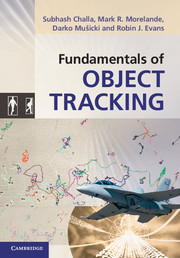Book contents
- Frontmatter
- Contents
- Preface
- 1 Introduction to object tracking
- 2 Filtering theory and non-maneuvering object tracking
- 3 Maneuvering object tracking
- 4 Single-object tracking in clutter
- 5 Single- and multiple-object tracking in clutter: object-existence-based approach
- 6 Multiple-object tracking in clutter: random-set-based approach
- 7 Bayesian smoothing algorithms for object tracking
- 8 Object tracking with time-delayed, out-of-sequence measurements
- 9 Practical object tracking
- Appendix A Mathematical and statistical preliminaries
- Appendix B Finite set statistics (FISST)
- Appendix C Pseudo-functions in object tracking
- References
- Index
3 - Maneuvering object tracking
Published online by Cambridge University Press: 07 September 2011
- Frontmatter
- Contents
- Preface
- 1 Introduction to object tracking
- 2 Filtering theory and non-maneuvering object tracking
- 3 Maneuvering object tracking
- 4 Single-object tracking in clutter
- 5 Single- and multiple-object tracking in clutter: object-existence-based approach
- 6 Multiple-object tracking in clutter: random-set-based approach
- 7 Bayesian smoothing algorithms for object tracking
- 8 Object tracking with time-delayed, out-of-sequence measurements
- 9 Practical object tracking
- Appendix A Mathematical and statistical preliminaries
- Appendix B Finite set statistics (FISST)
- Appendix C Pseudo-functions in object tracking
- References
- Index
Summary
Maneuvering objects are those objects whose dynamical behavior changes over time. An object that suddenly turns or accelerates displays a maneuvering behavior with regard to its tracked position. While the definition of a maneuvering object extends beyond the tracking of position and speed, historically it is in this context that maneuvering object tracking theory developed. This chapter presents a unified derivation of some of the most common maneuvering object tracking algorithms in the Chapman–Kolmogorov–Bayesian framework.
Modeling for maneuvering object tracking
In general, maneuvering object tracking refers to the problem of state estimation where the system model undergoes abrupt changes. The standard Kalman filter with a single motion model is limited in performance for such problems because it does not effectively respond to the changes in the dynamics as the object maneuvers. A large number of approaches to the maneuvering object tracking problem have been developed including process noise adaptation (Singer et al., 1974; Moose, 1975; Gholson and Moose, 1977; Ricker and Williams, 1978; Moose et al., 1979; Farina and Studer, 1985), input estimation (Chan et al., 1979), variable dimension filtering (Bar-Shalom and Birmiwal, 1982) and multiple models (MM) (Ackerson and Fu, 1970; Mori et al., 1986; Blom and Bar-Shalom, 1988; Bar-Shalom and Li, 1993), etc. These apparently diverse approaches may be grouped into two broad categories:
single model with state augmentation;
multiple models with Markovian jumps.
- Type
- Chapter
- Information
- Fundamentals of Object Tracking , pp. 62 - 102Publisher: Cambridge University PressPrint publication year: 2011
- 1
- Cited by

